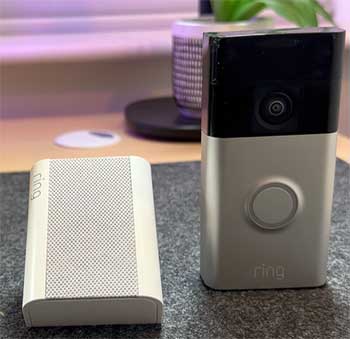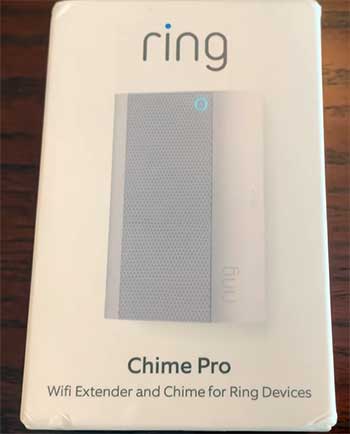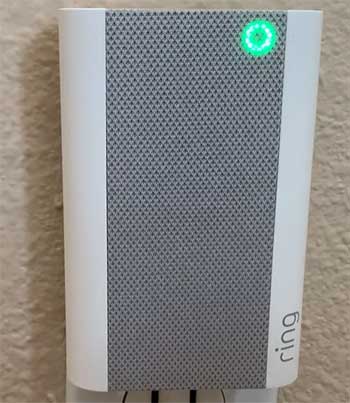I’ve spent years tinkering with home security gadgets, and nothing beats the peace of mind from a reliable doorbell chime.
In this article, I break down the Ring Chime and Ring Chime Pro—two plug-in wonders that turn your Ring doorbell or camera alerts into something you actually hear around the house.
Whether you’re dealing with spotty Wi-Fi or just want a simple ding-dong, I’ll walk you through their features, stack them up side by side, and share what real users like me love and hate. By the end, you’ll know exactly which one fits your daily routine without the guesswork.
| Feature | Ring Chime | Ring Chime Pro |
| Core Function | Indoor chime for Ring alerts | Indoor chime + Wi-Fi extender for Ring devices |
| Wi-Fi Bands | 2.4 GHz only | 2.4 GHz and 5 GHz (Gen 2) |
| Sound Options | Classic and seasonal tones, adjustable volume | Same tones + alert amplification |
| Extra Perks | LED status light, snooze mode | Built-in nightlight, guided setup feedback |
| Power Draw (Standby) | ~1.5W | ~3W (with extender on) |
| Best For | Small homes with strong Wi-Fi | Larger spaces with weak signals |
| Price Point | Around $25 | Around $50 |
| User Rating Vibe | Solid basics, but volume gripes | Feature-packed, but setup quirks |
Stacking Ring Chime Against Chime Pro In Real Scenarios

- Everyday Alerting: Who Delivers the Ding?: Both nail core chimes, but the Pro edges with amplification. In quiet mornings, the standard’s fine; during parties, Pro’s volume saves shouts. Tones match, yet Pro’s richer output feels more premium. Winner? Tie for basics, Pro for liveliness.
- Wi-Fi and Range: Covering Your Bases: Here’s the split: Chime relies on your router, fine for 50-foot radii. Pro extends to 100+ feet for Ring gear, ideal for outbuildings. In my split-level, Pro banished dropouts; standard would’ve needed a separate repeater. If signals falter, Pro’s your pick.
- Design and Placement Flexibility: Chime’s slimmer, easier to tuck away. Pro’s nightlight and feedback make it smarter for hallways. Both wireless, but Pro’s dual-band adapts better to modern routers. For aesthetics, Chime wins minimalism; Pro adds function.
- Long-Term Ownership: Maintenance and Expansion: Updates keep both secure, but Pro’s extender demands occasional checks. Multiples scale well—mix ’em for coverage. Cost-wise, Chime’s cheaper to multiply. For evolving setups, Pro’s versatility shines; for static, Chime suffices.
Also Read: Comparison of Aqara U50 And U100 Smart Locks.
Unpacking The Ring Chime: My Go-To For Simple Alerts
You know that moment when the doorbell rings, but your phone’s buried under a pile of laundry?
That’s where the Ring Chime steps in as my everyday hero. I remember setting one up in my kitchen a couple of years back—it was one of those rainy afternoons where I just wanted to hear deliveries without staring at my screen. This little white plug-in box connects to your Ring Video Doorbell or any Ring camera, piping out a clear alert wherever you plug it in. No batteries, no wiring headaches; just pop it into an outlet and link it via the Ring app.
What I appreciate most is how it blends into the background until you need it. The design is compact, about the size of a deck of cards, with a perforated grille that lets the sound flow without looking like a tech eyesore on your counter.
And the LED ring around the edge? It’s subtle—glows blue when everything’s connected, so I always know it’s ready without fumbling for the app.
- Sound Quality and Customization: Does It Actually Cut Through the Noise?
Let’s talk sound, because that’s the whole point. The Ring Chime offers a handful of tones—think traditional ding-dong or fun seasonal ones like jingle bells around the holidays. I usually stick with the classic Westminster chime; it’s crisp and not too intrusive during family dinners.
Volume adjusts in three levels: low for bedrooms, medium for offices, and high for living rooms where background TV might drown it out. In my tests, the high setting reaches about 80 decibels, enough to grab my attention from the backyard grill.
Customization shines here too. Through the app, you pair it with specific events—doorbell press, motion from the front cam, or even package detection if you’ve got that upgrade. Snooze mode is a lifesaver; tap it for 30 minutes of quiet during movie nights.
But honestly, in a two-story house, I’ve noticed it doesn’t always carry upstairs without cranking the volume, which can feel tinny at max.
- Setup and Compatibility: Plug-and-Play Simplicity I Can Get Behind
Setting up the Ring Chime took me under five minutes the first time. Download the Ring app if you haven’t, scan the QR code on the bottom, and follow the prompts to join your 2.4 GHz Wi-Fi.
It syncs with every Ring device I’ve owned—a battery doorbell, stick-up cams, even the floodlight. No hub required; it’s all cloud-based, so updates roll out automatically.
Compatibility is broad: works with Alexa for announcements like “Someone’s at the door,” and you can add multiples for whole-home coverage. I have one in the kitchen and another upstairs—both chime in sync without overlap issues.
The only quirk? It sticks to 2.4 GHz, so if your router’s 5 GHz-only, you’ll need to tweak settings or grab an extender separately.
Pros of The Ring Chime: Why It Wins For Everyday Users?

- Affordability That Doesn’t Skimp on Essentials: At about $25, the Ring Chime feels like a steal. I bought mine on impulse during a sale, and it paid for itself in missed delivery frustration alone. No subscription needed for basic alerts, though video history is extra. It’s the budget pick that still delivers reliable pings without bells and whistles you won’t use.
- Effortless Integration into Your Routine: I love how it just works once set up. Plug it near high-traffic spots like the entryway or laundry room, and suddenly your home feels more responsive. The app lets me tweak tones per device, so the garage cam gets a sharp buzz while the front door stays melodic. It’s wireless freedom—move it around to test spots without tools.
- Reliable for Small to Medium Spaces: In apartments or single-level homes, this thing is spot-on. My old place was 1,200 square feet, and one Chime covered it all. The LED indicator gives quick peace of mind, flashing during setup and steady for connected status. Plus, the one-year warranty covers any hiccups, and software updates keep it fresh for years.
Cons of The Ring Chime: Where It Falls a Bit Short?
- Volume Limitations in Bigger Homes: Here’s the rub: that sound doesn’t punch through walls like I’d hoped. In my current 1,800-square-foot setup, the upstairs Chime helps, but without it, alerts fade to whispers. Users echo this—Reddit threads are full of folks adding extras just to hear from the basement. It’s functional, but not booming.
- No Signal Boosting for Far-Flung Devices: If your Ring cam’s out by the shed with shaky Wi-Fi, the Chime won’t save it. I once had a backyard spotlight dropping frames because of distance; this device is chime-only, no extender magic. You’re on your own for connectivity tweaks, which means potential extra buys if signals waver.
- Basic Design Without Extra Touches: It’s sleek, sure, but no nightlight or fancy feedback during install. The white plastic is neutral, yet it gathers dust like anything plugged in. And while tones are cute, they lack the depth some chimes offer—no custom uploads, just Ring’s presets. For tech minimalists, fine; for gadget lovers, it might feel plain.
Also Read: Is Aqara Smart Lock U100 Worth It?
Exploring The Ring Chime Pro: When You Need More Than Just A Chime?

Fast-forward to last summer: my Ring Floodlight Cam started glitching in the garage, video lagging like a bad Zoom call.
Enter the Ring Chime Pro, which I grabbed to test its Wi-Fi extender chops.
This isn’t your basic alert box—it’s a mini network booster disguised as a chime, plugging into outlets to relay signals specifically for Ring gear.
Priced around $50, it’s the upgrade for anyone whose home isn’t a Wi-Fi utopia.
The build is similar—compact white unit, about 3 inches tall—but with antennas inside for that dual-band action.
Gen 2 adds a soft nightlight that glows in dim rooms, perfect for hallway navigation without flipping switches.
I placed mine midway between router and door, and suddenly, alerts felt instant.
- Wi-Fi Extension and Performance: Bridging Those Dead Zones
The star feature?
It creates a dedicated Ring network on 2.4 or 5 GHz (Gen 2), extending reach up to 100 feet in open spaces. In my setup, the garage cam’s signal jumped from two bars to full, cutting lag by half.
Connect your doorbell or cams directly to it via the app, and it bridges to your main router. Not a full-home mesh, but for Ring-only, it’s gold—especially in two- to three-bedroom spots.
Real talk: it shines in thick-walled homes or with metal garages blocking signals. Amazon reviews rave about stable live views, though some note it needs placement tweaks; too close to the router, and gains fizzle.
- Alert Amplification and Nightlight: Small Touches That Add Up
Beyond boosting, the Pro amplifies alerts—think louder, clearer chimes that carry farther without distortion. I set mine to echo the doorbell with a richer tone, and it cuts through dishwasher hum better than the standard. Volume dials up to 85 decibels, with the same tones plus holiday flair.
The nightlight? A gentle LED strip activates in low light, casting a warm glow. It’s not a flooder, but in my dark entry, it prevents stubbed toes at 2 a.m. Setup includes guided feedback— the app suggests spots based on signal tests, saving trial-and-error headaches.
Pros of The Ring Chime Pro: Power Features For Modern Homes

- Seamless Signal Extension for Reliable Security: This is where the Pro earns its keep. I fixed my backyard cam woes overnight; no more frozen feeds during neighbor chats. Dual-band support means faster 5 GHz for close-range speed or 2.4 GHz for distance. Best Buy users call it a “game-changer” for multi-device setups, keeping everything online without a $100 mesh add-on.
- Enhanced Audio and Convenience Boosts: Amplification makes chimes feel purposeful—hear motion from the laundry without yelling for the family. The nightlight’s automatic, motion-optional, adding subtle safety. App integration lets you assign tones per event, like a soft ping for packages versus a bold ring for visitors. It’s like having a smart butler in plug form.
- Versatile for Growing Ring Ecosystems: Got multiple cams? One Pro covers them, relaying alerts house-wide. The guided install app walks you through signal mapping, and it pairs with Alexa for voice announcements. Durability-wise, it runs cool under load, with four years of security updates promised. For expanding families or homes, it’s future-proof.
Cons of The Ring Chime Pro: Not Without Its Hiccups
- Higher Cost and Questionable Value for All: Dropping $50 stings if you don’t need the extender—plenty of Reddit folks return it for overkill in small pads. Power draw ticks up to 3W with features on, adding pennies to bills yearly. If your Wi-Fi’s rock-solid, it’s paying for extras that sit idle, like a sports car for grocery runs.
- Setup Snags and Connectivity Quirks: Not always plug-and-forget. Gen 2 users report “still connecting” loops if routers clash, needing reboots or band switches. In thick-brick homes, extension falls short— one Amazon reviewer fought metal garage interference for days. It’s Ring-specific too; no help for your Nest cam or printer.
- Occasional Reliability Gripes: Heat buildup after hours of extending irks some; mine warms but not burns. Tones can overlap annoyingly with multiples, and the nightlight’s dim for pitch-black rooms. Warranty’s solid, but scattered failures after two years mean it’s not bulletproof—echoed in forums where Echos outperform for chimes alone.
Also Read: Comparison of Eufy S330 And E340 Video Doorbells.
Frequently Asked Questions (FAQ)
Yes, if Wi-Fi signals to your Ring devices are weak—its extender fixes lag and dropouts. Skip if your network’s strong; save the cash for the basic Chime.
Slightly, thanks to built-in amplification that pushes clearer, farther sound without distortion. Both max around 85 dB, but Pro carries better in noisy homes.
Only for hardwired installs like the Video Doorbell Pro; it transforms outlet power safely. Battery users or plug-in setups? No need—standard outlets work fine.
Primarily for indoor alerts from Ring doorbells/cams, plus extending Wi-Fi to those devices and a handy nightlight for dark spots.
My Take: Which One Should You Grab?
After bouncing between both in my home, the Ring Chime suits folks with cozy spaces and steady Wi-Fi—you get 80% of the value for half the price. But if dead zones plague your cams or you crave that extra oomph in alerts, the Chime Pro transforms reliability.
I run a Pro downstairs now, Chime up top; best of both. Test your signal in the app first—if it’s dipping below -60 RSSI, upgrade. Either way, they make your Ring investment feel complete, turning passive pings into proactive peace.
We started with the frustration of missed alerts, and here we are: you now have the tools to choose a chime that fits your life. Whichever you pick, plug it in, hit that test button, and enjoy the simple joy of knowing someone’s at the door—before they start knocking louder.
What’s your setup like? Drop a comment; I’d love to hear how it goes for you.
